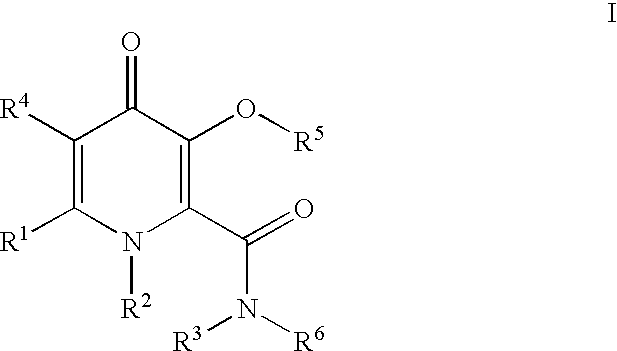Processes for the manufacturing of 3-hydroxy-N,1,6-trialkyl-4-oxo-1,4-dihydropyridine-2-carboxamide
- Summary
- Abstract
- Description
- Claims
- Application Information
AI Technical Summary
Benefits of technology
Problems solved by technology
Method used
Image
Examples
example 1
Preparation of Chlorokojic Acid
A 2-liter 3-neck round bottom flask was equipped with a mechanical stirrer. The flask was charged with kojic acid (0.25 kg, 1.759 mol) and 750 ml acetonitrile at 0.degree. C. The kojic acid was insoluble in acetonitrile and stayed as a suspension. Thionyl chloride (140 ml, 1.919 mol) was added dropwise via a dropping funnel at ice bath temperature. The solid slowly dissolved to give a red clear solution. After 15 minutes, a white solid appeared. After 3 hrs at 0.degree. C., the insoluble solid was filtered. The solid was filtered by suction filtration. The solid was mixed with water (0.5 L) and then filtered. The acetonitrile mother liquor was reduced to 15% of the original volume and filtered. The solid was washed with water (200 ml) and then acetonitrile (50 ml). The combined solid was dried to constant weight. (269 g, 95.2% yield). M.p. 166-168.degree. C. [lit value 166-167.degree. C.]. 1H-NMR (DMSO-d.sub.6) .delta.: 4.66 (s, 2H, CH2Cl), 6.57 (s,1H,...
example 2
Preparation of 3-(Benzyloxy)-2-(hydroxymethyl)-6-methyl-4H-pyran-4-one
Procedure I:
Allomaltol (Chem Abstract 1968-51-0P) was prepared from chlorokojic acid according to literature procedure published in J. Med. Chem., 1996, 39, 3659-3670. Allomaltol (12.6 g, 0.1 mol) was added to a solution of sodium hydroxide (4.4 g, 0.11 mol) in water (60 ml). Formaldehyde (9 ml, 37% solution, 0.111 mol) was added dropwise at 0.degree. C. The mixture was stirred at room temperature. A solid started to appear after 1.5 hr. Methanol (50 ml) was added and the mixture was left stirring for 16 hrs. The mixture was heated to 40.degree. C. to effect dissolution of all insoluble solids. Benzyl chloride (12.65 ml, 0.109 mol), tetra-N-butylammonium chloride (71 mg, 0.25 mmol) was added. The mixture was heated to reflux for 3.5 hr. The solution was cooled and the pH of the solution dropped to pH=1. A solution of sodium hydroxide (2.5 g, 0.0625 mol) in water (10 ml) was added. PhCH.sub.2 Cl (2 ml, 0.0173 mol) ...
example 3
Preparation of 3-(Benzyloxy)-6-methyl-4-oxo-4H-pyran-2-carboxylic Acid
Procedure I:
A 1-liter 3-neck round bottom flask was equipped with a mechanical stirrer and a dropping funnel. Dichloromethane (100 ml) was added to the flask followed by 3-(benzyloxy)-2-(hydroxymethyl)-6-methyl-4H-pyran-4-one (15.87 g, 0.064 mol). Sodium bicarbonate solution (10%, 100 ml, 0.12 mol) was added, followed by solid sodium bicarbonate (13.5 g, 0.161 mol) and potassium bromide (764 mg, 6.42 mmol). The mixture was cooled in an ice bath. The internal temperature of the reaction mixture was 3.degree. C.
TEMPO (100 mg, 0.64 mmol) and tetra-n-butylammonium chloride hydrate (750 mg, 2.7 mmol) were added. Sodium hypochlorite solution (14.6%, 23 ml, 0.045 mol, see note 3) was added dropwise, maintaining the reaction temperature below 7.degree. C. The addition of sodium hypochlorite solution (14.6%, 23 ml, 0.045 mol) took 25 minutes..sup.1 The pH of the top layer was checked and measured a value of 9.0.
Sodium hypo...
PUM
| Property | Measurement | Unit |
|---|---|---|
| Angle | aaaaa | aaaaa |
| Temperature | aaaaa | aaaaa |
Abstract
Description
Claims
Application Information
 Login to View More
Login to View More - Generate Ideas
- Intellectual Property
- Life Sciences
- Materials
- Tech Scout
- Unparalleled Data Quality
- Higher Quality Content
- 60% Fewer Hallucinations
Browse by: Latest US Patents, China's latest patents, Technical Efficacy Thesaurus, Application Domain, Technology Topic, Popular Technical Reports.
© 2025 PatSnap. All rights reserved.Legal|Privacy policy|Modern Slavery Act Transparency Statement|Sitemap|About US| Contact US: help@patsnap.com



